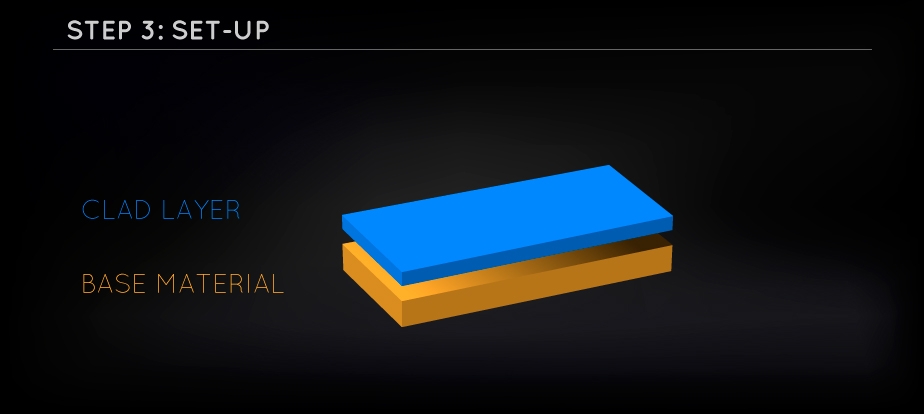Incepand cu 2021 BSW Metals are onoarea de a fi reprezentant exclusiv pentru firma Shockwave Metalworking Technologies BV (SMT) din Olanda, companie fondata in 1962 si cu mai mult de 40 de ani de experienta in placarea prin explozie.
Putem oferi astfel o mare varietate de table placate la preturi competitive si cu un timp de livrare foarte bun.
Datorita tehnologiei unice de explozie in vacuum putem gestiona toate tipurile de combinatii de materiale si proiecte de diferite marimi.
Explosive Cladding by Vacuum Technology
Explosive cladding is also known as explosion welding. It is the bonding of two or more dissimilar metals with the aid of explosives. It is accomplished by a high-velocity oblique impact between two metals.
The impact produces sufficient energy to cause the colliding metal surfaces to flow hydro dynamically when they intimately contact one another
in order to promote solid-state bonding. The metal surfaces are compressed together under high pressure from the explosion, and an atomistic bonding between the dissimilar metals will be accomplished.
Explosive cladding is a cold ‘pressure weld process (at room temperature)’. It is a method to weld metals that cannot be welded by conventional processes,
It is a method to weld metals that cannot be welded by conventional processes, such as titanium-steel, aluminium-steel and aluminium-copper. It can also be used to weld compatible metals, such as stainless steels and nickel alloys to steel. The cladding metals are typically stainless steel, duplex steel, titanium, aluminium, copper, copper alloys, nickel, nickel alloys, tantalum, and zirconium.
Fabrication Process
The cladding process is started with the preparation (Grinding and Cleaning) of the surface of both base material and clad material. The clad material is placed on top of the base material and between the two materials we place spacers to keep an appropriate ‘stand-off’. The assembly of the materials is accomplished in accordance with the clad set-up parameters
(stand-off gap, quantity of explosives, surface protection, ignition point). The clad assembly will be put in the vacuum chamber, on top of a prepared sand bed. The powder explosives will be applied on the clad surface together with the booster charge. After placing the electrical detonator, the vacuum chamber will be closed
and the evacuation of the air will start. When the under pressure reach the required value, the detonation of the explosive charge will take place by ignition the detonator at the control room.
The cladded plates will be further prepared for finishing: Visual check, flattening, US examination, DT/NDT and packed for transport.

Main Applications
Explosion-welded clad metals are used in a wide range of industries like: oil and gas, chemical and
petrochemical, desalination plants, steel mills & hydrometallurgy, aluminium smelters, shipbuilding, power
generation, and other industries where corrosion, temperature and pressure are important parameters.

Chemical & Petrochemical :
Corrosion Resistance layer
• headplates • shellplates • tubesheets

Shipbuilding:
Aluminium / Steel – Transition Joint:: Triplate®

Electrical :
Electrical Transition Joint (Anode – Cathode blocks)
Cladding Materials
The base metals are typicaly carbon steel, stainless steel, alloy steel, copper and aluminium.
The cladding metals are mainly stainless steel, duplex steel, titanium, aluminium, copper, copper alloys, nickel, nickel alloys, tantalum, and zirconium.

Base Metals
• PLATES
o CS A-55, A-516, A-537 o Alloy Steel A-387, A-204
• FORGINGS
o CS A-266, A-350 o Alloy Steel A-387, A-204
• SS PLATES & FORGINGS
o 300 series
Product Type
• Flat plates (square/rectangular)
• Round discs (heads/tube sheets)
• Pipes / LWN.
Sizes / Capacity
Maximum Length: 11.000 mm
Maximum width: 4.200 mm
Maximum total area: 25 m2
Maximum piece weight: 25 MT
Base material thickness: 1 – 500 mm
Clad material thickness: 1 – 25 mm
Cladding Metals
• 300 series SS
• 400 series SS
• Duplex and Super Duplex
• Nickel Alloys
o Alloys 200, 400
o Alloys 600, 800
o Alloys 625, 825
o Alloys 900
o Alloys C-276, -22
o Alloys C-2000
o Alloys 59
o Hastelloys
• * Copper Alloys
o Copper Nickel
o Naval Brass
o Aluminium
o Aluminium Bronze
• Titanium
• Zircunium
• Tantalium
• Other Metals (on request)
Advantages of Explosion Cladding under Vacuum:
• Short delivery time: complete production under one roof
• Excellent process control (no weather influences and circumstances)
• Because of vacuum, less explosives are required.
o As results:
– Less deformation
– Hardness of the clad plate slightly increase
• Costs saving: thin layer of expensive material cladded on a thicker layer of cheap material.
• Metal combinations possible which are conventional impossible to weld.
• Original metal properties maintain.
• Joint/bond stronger than the weakest material.
• Oxide free atomic bond
• Electrical resistance of anode / cathode blocks nil
• Required clad layer thickness in 1 step realized
• Smooth surface after cladding
• Intermediate quality control not necessary
Quality & Testing
• Procedures acc. To ISO 9001 (since 1992)
• Testing of the explosive cladded material:
o Ultrasonic Testing
o Destructive testing:
– Tensile test
– Bend test
– Shear test
– Impact test
– Fatigue test









